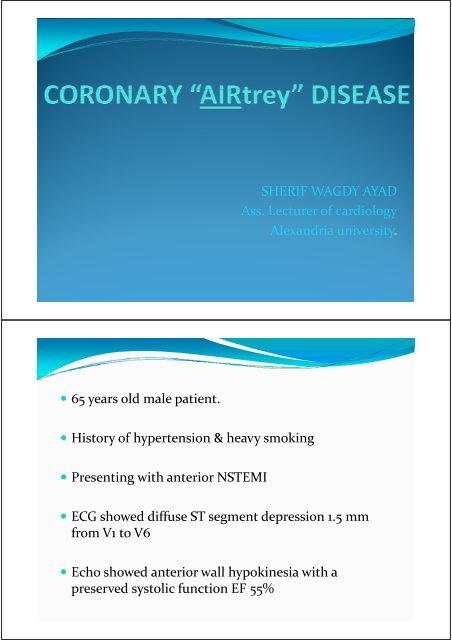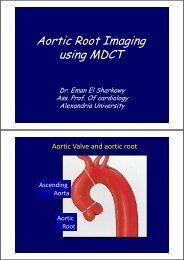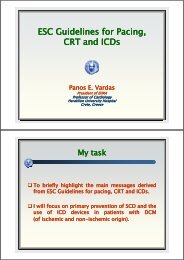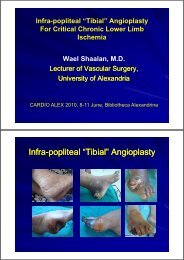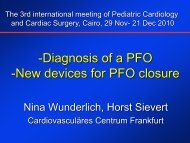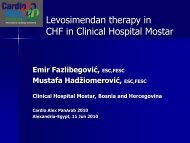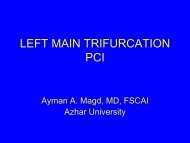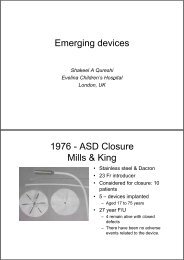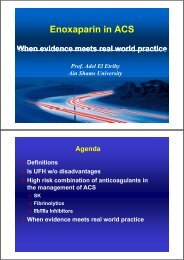SHERIF WAGDY AYAD SRG Ass. Lecturer of cardiology Alexandria ...
SHERIF WAGDY AYAD SRG Ass. Lecturer of cardiology Alexandria ...
SHERIF WAGDY AYAD SRG Ass. Lecturer of cardiology Alexandria ...
- No tags were found...
You also want an ePaper? Increase the reach of your titles
YUMPU automatically turns print PDFs into web optimized ePapers that Google loves.
• The patient was admitted to CCU & receivedAspirin 150mgclopidogrel loading 600mg followed by 75 mg.LMWHglycoprotein IIB/IIIA inhibitors• After 24 hours no resolution <strong>of</strong> chest pain or ECGchanges.• The patient was referred to cath. lab.Coronary angiography• LMCA: Normal bifurcating into LAD, LCX.• LAD: Proximal tight lesion with 95% stenosis followedby another mid to distal lesion with 90% stenosis &TIMI II distal flow.• LCX: Proximal atherosclerotic plaque with nosignificant lesion.• RCA: Mid RCA lesion with 50% stenosis & good distalRCA: Mid RCA lesion with 50% stenosis & good distalflow
• After discussion with the patient & the family decisionwas PCI to LAD with 2 BMS .• 6 FR XB 3.5 guiding catheter for engagement <strong>of</strong>LMCA was chosen.Before eoeengagement, e t,during test dye‐injection,the manifold fractured due to badmanufacture allowing AIR into the system !!!!!
• Few seconds later, the patient c/o <strong>of</strong>severe chest pain associated with hypotension, hisBP fell to 60/40, bradycardia with HR 35/min.• ECG at this moment showed ST elevation 2mm in theinferior leads.• Immediate control angio for the RCA which revealed
• Patient HR dropped to 20 & he was not responding toatropine & lastly…….. l ARRESTED.• Immediate insertion <strong>of</strong> temporary pace maker.What to do next ?????
• The decision <strong>of</strong> auto transfusion <strong>of</strong> blood from theaorta and manual reinjection under high pressurerepeated several times aiming to disrupt these airbubbles or push them distally was successful & weregained TIMI III flow into RCA.
• Even though TIMI III flow was regained into RCApatient still had severe chest pain & severehypotension• Decision to control angio <strong>of</strong> the left system wastaken & revealed a bad surprise !!!!
• We tried to do for the LAD the same as we did for theRCA with auotransfusion <strong>of</strong> blood from aortareinjected manually under high pressure into LAD.• This was repeated several times but still noimprovement <strong>of</strong> flow into LAD !
• At this point patient BP 80/50.• Chest pain decreased a little.
So now…What do YOU think ??• To stop procedure & give full medical therapy thencontinue procedure 24 HR later?OR• To do PCI <strong>of</strong> LAD as was planned before Airembolism?• While deciding patient BP dropped again & chestpain increasedPCI LAD.
• Patient BP returned to normal, with normal sinusrhythm, pace maker was shut down but kept in placefor 24 hrs.• Patient had smooth course in CCU & was dischargedhome after 3 days free <strong>of</strong> symptoms .Take Home Message :• Coronary air embolism is an uncommon complicationduring coronary angiography & PCI.• Mild forms <strong>of</strong> air embolism may pass uneventful ormay cause transient bradycardia & hypotension.• Severe air embolism is a serious condition that mayend by serious ventricular arrhythmias h (VT/VF),cardiac arrest & death.
• Review <strong>of</strong> literature for management <strong>of</strong> coronary airembolism:‐Catheter aspiration.‐ high pressure injection <strong>of</strong> saline or blood from aortainto culprit artery manually may resolve the condition.• Sometimes with underlying significant coronarystenosis , air bubbles are trapped behind occlusion, soPCI must be done.• ALWAYS double check the system before starting &ensure absence <strong>of</strong> air by yourself, as at the end thepatient’s life is your responsibility….. ALONE.


